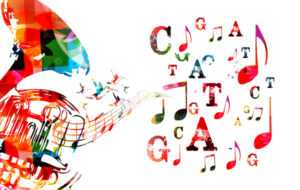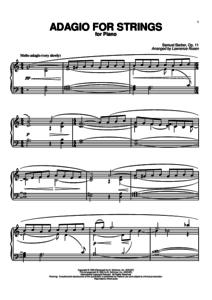Recently I wrote about the completion of the human genome sequencing project and the promise, problems and questions that the project has generated in the last decade and a half. One of the biggest realizations that I had from researching and writing that post is that our human genome makes us more alike than different at the molecular level, yet there is incredible variability in the human species around the globe.
I started to think about other things where the basic building blocks were the same, yet the final products were so very different—and I landed in the middle of a symphony orchestra.
Orchestras, if we look at the instruments that they have at their disposal, are very similar: dare I say 99% identical? For instance the instruments listed in the February 2017 roster for the New York Philharmonic Orchestra on Wikipedia (1) are very similar to the lists of instruments listed for the musicians of the Atlanta Symphony Orchestra on its web site (2). Numbers and groupings might vary, but the instruments are the same.
However no one would argue that the New York Philharmonic Orchestra and the Atlanta Symphony Orchestra and Chorus are interchangeable. Experiencing one is not the same as experiencing the other, and two separate experiences of either are often completely different.
The orchestral “DNA” is the same: highly trained musicians playing essentially the same set of instruments, and quite often the same piece of music. What makes each experience of these organizations unique is the when, the where and the how of the expression of that DNA.
In graduate school I was fortunate to hear the string section of the Atlanta Symphony Orchestra perform Barber’s Adagio for Strings. I was taken on an emotional journey that I had never before experienced from live music. Several years later, I had a completely different experience when I heard a smaller local orchestra perform that same Adagio for Strings. The second experience was moving, maybe not moving me to tears like the first did, but it was equally as valuable for me as a listener. The second time I heard the piece, I had attended a brief lecture by the conductor about the piece, and I heard things musically that I had not heard the first time.
What made the experiences different? It was the same piece of music. The same notes, essentially the same instruments. Several factors played into the experience of the music in the two settings, and they are the same kinds of factors that influence how the cells of your body “play” your genome.
Environment. The first time I heard Adagio for Strings, I was in Symphony Hall—a place specifically designed to experience symphonic music. The second time I heard the piece, the hall wasn’t so acoustically magnificent. Just like the acoustical environment affects the sounds that surround you when you hear live music, environment affects gene expression in our cells.
Cells starved for nutrients express a different set of genes than cells that have all they need to grow and divide. Cells soaked in signals from stress hormones from other parts of the body express genes differently than cells not exposed to those hormones. An embryo or fetus exposed to lead or environmental estrogens from drinking water is going to have a different pattern of gene expression, (what genes are on and off, when, where and for how long) than an one not exposed to these chemicals—and those different expression patterns will have long-term developmental consequences. Your diet and the microbes in your gut can even affect the way the cells of your intestine express genes (3).
Previous experience. The conductor, musicians and listeners all bring previous experiences, their own training and the biases of their mentors to the music. They’ve sat in concert halls, taken music history and appreciation classes, and studied theory under venerable professors. All of these experiences affect how they play, coach or even listen to the music. For instance, one conductor may silence a section of the orchestra for a few seconds longer than another for a held rest. One trumpet player may attack a sforzando more strongly than another because that is the way their music teacher taught them when they were learning.
Just like a music teacher influences the musician who in turn influences the final performance of the piece, transgenerational epigenetic effects, modifications to the genome in one generation that are inherited by following generations, have been well described in model genetic organisms (4,5), and now some studies suggest that the experience of your grandmother can affect the developing germline of the child she carried in her womb (your parent) through epigenetic modifications, and those modifications can affect gene expression in you (4–6). These modifications affect how your genome is orchestrated to produce you. These transgenerational effects seem to escape the “embryonic reset” that is thought to wipe the genome clean—just like the conductor or musician is never completely without their experience of the music, even though they may try to approach a piece with fresh ears.
So, as humans, we are more alike than different at the level of our genome. Which is something to embrace. It gives us common ground, just like the instruments and a common piece of music serve as a starting point for any orchestral experience. However, the genome is delightfully flexible and influenced by environment and previous experience and the result is the incredibly varied, gifted and unique individuals that make up our human species. It is in this variety and variability that we find our hybrid vigor and our strength as a species.
Happy #humangenomemonth
Literature Cited
- New York Philharmonic https://en.wikipedia.org/wiki/New_York_Philharmonic [Internet: accessed April 26, 2018]
- Atlanta Symphony Orchestra “About” https://www.atlantasymphony.org/About/ConductorsAndMusicians [internet: accessed April 26, 2018]
- Gut’s microbial community shown to influence host gene expression https://news.wisc.edu/guts-microbial-community-shown-to-influence-host-gene-expression/ [internet: accessed April 29, 2018]
- Transgenerational Epigenetic Inheritance: myths and mechanisms https://www.ncbi.nlm.nih.gov/pmc/articles/PMC4020004/ [internet: accessed April 29, 2018]
- Transgenerational genetic effects https://www.ncbi.nlm.nih.gov/pmc/articles/PMC3720237/ [internet: accessed April 29, 2018]
- Change in paternal grandmothers´ early food supply influenced cardiovascular mortality of the female grandchildren https://bmcgenet.biomedcentral.com/articles/10.1186/1471-2156-15-12 [accessed April 29, 2018]
Michele Arduengo
Latest posts by Michele Arduengo (see all)
- An Unexpected Role for RNA Methylation in Mitosis Leads to New Understanding of Neurodevelopmental Disorders - March 27, 2025
- Unlocking the Secrets of ADP-Ribosylation with Arg-C Ultra Protease, a Key Enzyme for Studying Ester-Linked Protein Modifications - November 13, 2024
- Exploring the Respiratory Virus Landscape: Pre-Pandemic Data and Pandemic Preparedness - October 29, 2024


